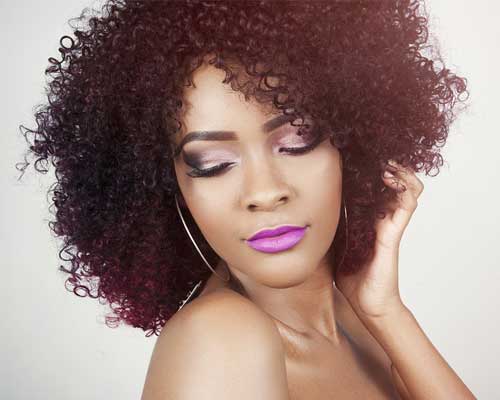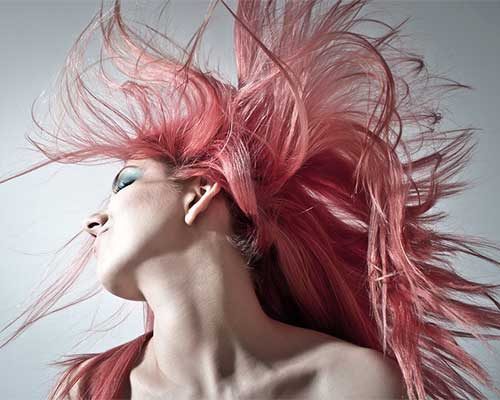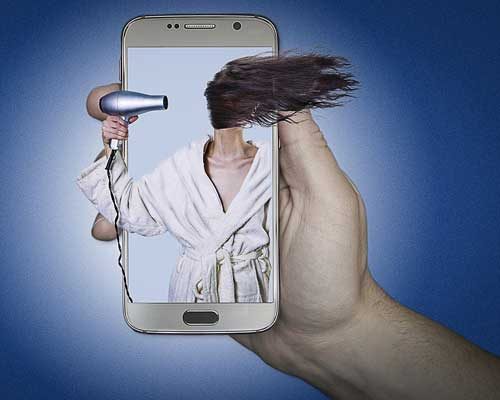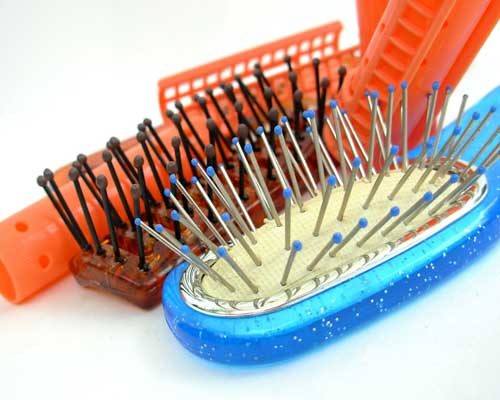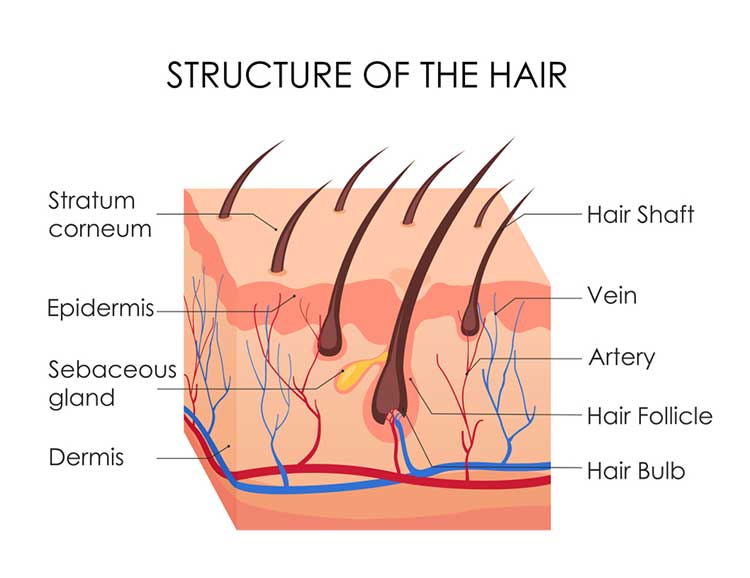
If I ask you, which topic has an importance in cosmetic science?
Please, take a break.
You needn’t search on Google for answering the question because you know the answer. Actually, you have come here to know about your hair structure and hair anatomy. Besides, you have an interest to get hair care tips and tutorials. However, I know! It is ridiculous to you because I am asking you about of cosmetic science here. Also, I’m pretty sure that you are not finding out any relevance with our discussed topic. I understand this, so, I am ensuring you; there is a strong relationship between your hair structure and cosmetic science what I will discuss in more detail later.
Well!
When you select your desired hair care products, then surely you prioritize the characteristics of your products and prefer to research a bit before taking your buying decision. Exactly, we are discussing that and our relevancy is here. Just like that, you involve with cosmetic science unknowingly. But, you don’t have interest to buy anything randomly. Because you are interested to know, how these products will react with your hair. After that, you want to take your decision.
Isn’t it?
Indeed, to say that most hair care products are generally made depends on your basic hair structure and hair type. So if you don’t have any knowledge about this, then most probably you won’t be able to choose the perfect products for your hair care.
Furthermore, most of us somehow plagued with various hair care problem. For instance; maybe someone worries about his or her hair loss or maybe about their hairstyle or hair care, so we are in a big trouble. But before finding out the solution to this problem, first, you need to know about your hair structure anatomy. Though it’s not easy to understand but remember that only it will disclose the mystery of your hair care problem.
Since the structure of a human hair has a deep relationship with our skin structure, so first we will know about our skin structure before diving into the hair structure portion.
The structure of human skin and relation with the human hair structure:
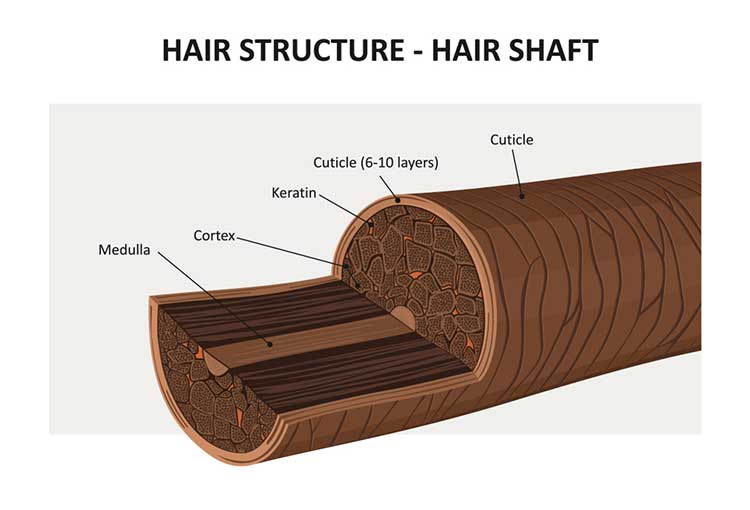
Generally, we wear clothes to protect our body from exterior elements or substances. Likewise, our body also has a built-in defense system and it’s our skin. And it is the largest organ of a human body. Mainly it protects our body’s internal parts from outer environments such as sun rays, water, bugs, and infections. It also plays an important role to control our body temperature by cooling sweat glands and warming the goosebumps.
Basically, human skin made up of two parts; one is Epidermis and another one is Dermis.
Epidermis: Epidermis is the first layer of skin to protect the human body. But the main role of it is to give the body a solid and stable protection.
Dermis: It is the thinnest part of a human skin. Generally, it contains blood vessels, connective tissues and the last part of nerves. So the main role of a dermis is to supply nutritional substances for the growth of our skin cells in the epidermis. It also contains a person’s sebaceous glands; these glands surround the hair follicles and lymphocytes and produce oily sebum to lubricate our skin and hair.
So far, we have discussed human skin and its main parts epidermis and dermis. That is why; I hope it will help you to get a clear outline of the structure of human hair.
Of course, you know human hair structure is closely related to human skin. Usually, our skin provides a strong and stable protection to all our internal and sensitive organs within our body. So it’s normal for having a strong relationship with each other.
Moreover, hair is a modified skin. And also you know sebaceous glands and follicle are two most important components of a hair strand. But these two components exist in the human skin’s dermis.
So if we want to talk about the hair anatomy, then the existence of sebaceous glands and follicles in the dermis showed us the relation between our skin and hair. So I think it’s not necessary to explain again.
Now, we need to focus on our main topic and know the details about our hair structure.
What is a hair structure?
Generally, human hair consists of a kind of hard protein called keratin. It gives a strong and stable shape of our hair, nail and outer skin in the body. On the other hand, Keratin is a large molecule which consists of a smaller unit called amino acids.
Basically, a complete hair strand has two main parts: a hair root and a hair shaft, so the human hair structure made up of these two parts. If you know the details, then it will be easier for you to treat the damaged areas of your hair and your hair will get a new life.
Hair Root: Hair root is the first step for you to understand your hair structure and get a clear view of the hair anatomy. To understand easily you can imagine a strand of your hair as a tree or a plant. Because when you will judge it to see the hair on your scalp, then you won’t be able to understand the internal functions of your hair.
Naturally, the roots of the tree expand from the ground’s depth, like that human hair roots also expand from the bottom of the skin. Further, it also preserved in the depth of your scalp’s skin where the dermis presents and in the follicle where your hair grows and changes its color.
However, the hair follicle contains a tube-like structure underneath in the main skin of hair. Besides, new cells are formed at the hair root and gradually these have been growing and dividing, after that, it comes out and increases our hair growth. So it’s said that a complete hair strand consists of a hair root or a hair follicle and a hair shaft.
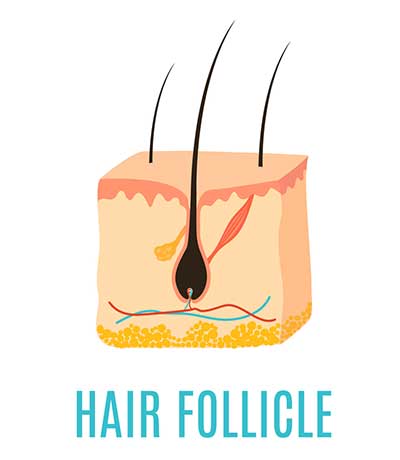 Hair Follicle: A hair follicle is a kind of membrane, which is similar to a bag. Generally, it contains the connective tissues and cells and also surrounds a hair root. That means a strand of our hair grows from this point. So hair follicle is an essential factor in a human hair structure.
Hair Follicle: A hair follicle is a kind of membrane, which is similar to a bag. Generally, it contains the connective tissues and cells and also surrounds a hair root. That means a strand of our hair grows from this point. So hair follicle is an essential factor in a human hair structure.
Also, it exists in the skin’s top two layers; dermis and epidermis. We also make it clear by using an example of a flower tub. According to the example, you can imagine flower plant as your hair strand and a tub as your hair follicle. So the topic is very simple and straightforward.
There is approximately 2-5 million hair follicles are still in our body; in this range, one hundred thousand to one hundred fifty thousand existed only in our head.
Papilla of hair: Papilla consists of connective tissues and blood vessels. Mainly it supplied essential nutrient elements in our hair. If we are talking about our hair growth, formation, and cycling, then papilla is responsible for all of these.
Germinal Matrix: Germinal matrix consists of several epithelial cells, which surround the papilla. It also contains another cell named melanocytes, which is responsible for producing melanin. Actually, melanin is a kind of pigment and it’s responsible for our skin color. Germinal matrix is also called as a matrix.
Hair Bulb: Hair bulb is the basement of our hair root and also an important part of a hair follicle. It’s a bulb-shaped element. It also surrounds the papilla and the germinal matrix. It’s an only living part of our hair components because what we have seen in our head is actually the dead cell. Besides, hair bulbs also contain most essential hormones to help our hair growth and formation it in various stages of our life like adolescence and pregnancy.
Root Sheath: It’s a part of our hair follicle, which consists of epithelial cells and completely covered our hair roots. Usually, the hair follicle closely relates to our hair growth. That is why it’s very important to properly take care of our hair follicles and know more about the details of it.
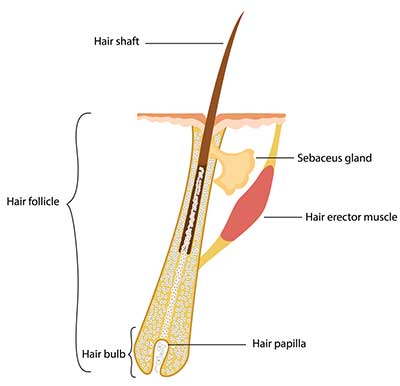 Hair Shaft: The part of the hair what you have seen on your head’s skin is called the hair shaft. Actually, the hair shaft consists of old dead cells. On the other hand, when the new cell grows at our hair root, then it pushed the old cells upwards. Then the old cell comes out and visible to us as a real hair. Since these all old cells are dead, so we don’t feel any pain during our hair cut. And it’s the one and only reason for not getting any pain while cutting our hair.
Hair Shaft: The part of the hair what you have seen on your head’s skin is called the hair shaft. Actually, the hair shaft consists of old dead cells. On the other hand, when the new cell grows at our hair root, then it pushed the old cells upwards. Then the old cell comes out and visible to us as a real hair. Since these all old cells are dead, so we don’t feel any pain during our hair cut. And it’s the one and only reason for not getting any pain while cutting our hair.
Generally, the hair shaft has three parts, such as medulla, cuticle, and the cortex.
Medulla (Internal Layer): Medulla is the most internal layer or part of our hair strand. Basically, it consists of round cells and a hollow space of air. However, the appearance and the presence of a medulla can be different depends on our hair type and from person to person. For example, your hair strand simultaneously can contain a complete medulla and also may contain a fragmented medulla, or may not contain any medulla. Typically, the tendency of having a medulla in thicker hair type is very high, whereas fine hair type does not contain any medulla.
So far, scientists are not fully informed about the proper functioning of the medulla. But they think it’s a kind of extended part which can be seen in depigmented or white hair. Generally, it’s used to determine the species. For instance; human medulla is different than animals’ medulla. That means human medulla is smaller, on the other hand, animals medulla is very thick.
Cuticle (Outer Layer): Cuticle is the outermost layer of a strand of hair. It works as a protein’s shield into the cortex. It consists of several layers (approximately 6-11), which looks like rough pebbles. But the most interesting fact is, these pebbles like structure can be opened and closed. So they can easily control the flow of water and moisture into the cortex.
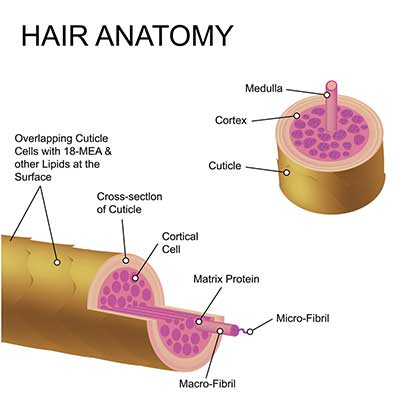 Cortex (Middle Layer): Cortex is the middle layer of a strand of hair. It is composed of 70%-95% of the total amount of our hair. It contains metabolized amino acids, which produces our hair color. So cortex is the main foundation of our hair’s structure, color, strength, and stability.
Cortex (Middle Layer): Cortex is the middle layer of a strand of hair. It is composed of 70%-95% of the total amount of our hair. It contains metabolized amino acids, which produces our hair color. So cortex is the main foundation of our hair’s structure, color, strength, and stability.
Moreover, the cortex is comprised of long strands and cells of the keratin protein, but these strands act as rubber brands and provide strength and flexibility to our hair. So when we stretch our hair and release it, then our hair goes back to its original shape again. This will only happen when we will have a healthy hair structure; if we don’t have a healthy structure then it won’t return to its original shape. Even it can tear off during stretching.
I hope this post gave you a clear outline of your hair structure. So now you will able to understand your hair type and sort out most effective hair care products for your hair with ease.
If you have any new ideas, opinions, and views then sharing this with me through the comment section. Besides, if you feel something boring to understand about your hair structure, then inform me also and I will try my best to help you.
